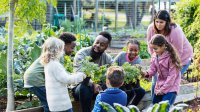Using Digital Tools to Enhance a School Garden Curriculum
Students can use technology to conduct research into weather, ecosystems, and more, and to showcase their learning.
When our graduating fifth graders are asked, “What was your favorite subject in school?” many of them say “Recess.” We all know kids love to be outside, and integrating outdoor activities into the curriculum can foster engagement and real-world connections while almost feeling like recess.
As a gifted resource coordinator, I’ve been fortunate enough to start a school garden at our elementary school. We now have over 3,000 square feet of garden space, a certified monarch butterfly way station, and a large greenhouse. We’ve also developed ways to integrate technology into our students’ gardening experience.
Starting our School Garden
As a school with limited means, we were challenged with finding ways to fund our project. We wrote grants to our public school foundation, Lowe’s Home Improvement, Monarch Watch, and several others. There are many organizations that provide money or supplies for school gardens. Our fourth-grade students also made calls to local businesses asking for discounts on supplies, which helped our money go further. Once we secured our first funding, we started a small salsa garden, and the benefits we saw with our students encouraged us to make additions.
A school garden can help teachers address state standards such as weather, environment, life cycles, human impact, and ecosystems, and so much more can be addressed in a school garden. School gardens can encourage healthy eating habits, provide a real-time look at the seed-to-spoon process, cultivate connectedness with nature, foster community involvement, and create opportunities for students to get off their screens and be outside. However, they don’t need to be off their screens all of the time, because even in the garden there are digital tools that can meaningfully enhance learning.
9 Ways to integrate technology into a school garden curriculum
1. Learn your garden vocabulary: There are many things to find in the garden, so why not have a scavenger hunt? Goosechase is a digital scavenger hunt app that allows students to take pictures and videos of their findings. Our intermediate grades learned vocabulary—“Make a video using a trowel correctly”—and then they created a scavenger hunt for our primary grades to help them become familiar with the garden. They were given tasks like “Take a picture of a leaf that is bigger than your hand.”
2. Collect data: We used Google Forms and Google Sheets to document our garden. We were able to weigh and measure what we harvested, documented the seeds we harvested, and kept a running notebook of plant progression. Primary grades spent time measuring and weighing potatoes as well as documenting timelines of seed sprouting and growth. Intermediate grades documented the weight of weekly harvests and kept a running account of flower sales.
3. Research it: We let students choose a vegetable, berry, herb, or flower to research and become an expert. We used the From Seed to Spoon app to conduct research about growing each plant. Students documented things like how to plant the seeds, the amount of sun needed, the time of year to plant and harvest, and what pests to look out for. Their findings were recorded using Google Forms and Google Sheets.
4. Draw it: We used the Osmo Masterpiece app to draw plants in the garden. This app allowed students to trace a picture, then replay it in fast motion. It made every student’s drawing look like it was done by a professional artist. We then had an art exhibition and contest, and the winners’ drawings were used in our Lulu publishing research book.
5. Publish it: We used Lulu to publish a research book from students’ From Seed to Spoon facts. Each student published one page with information about growing their plant. Students included facts like sunlight needs, days to harvest, and seed planting depth. Their favorite section was the “fun facts” about each plant. We discovered that the average strawberry has 200 seeds.
6. Make an app: After collecting data for our garden book, we used Glide to make an app to share our research with others. Glide easily produces an app by taking information from your Google Sheets. All you have to do is choose layouts and colors.
7. Make it funny: I know there is controversy over AI, but it sure can tell a joke. We used ChatGPT to find garden riddles (Q: “What is a bunny’s favorite dance form?” A: “Hip-hop!”). Then students used Pixton to illustrate and produce a comic of their own.
8. Record your progress: Use iMovie to document the progress of your garden. Our fourth grade went through the writing process and produced a movie of the history of Madison’s Square Garden.
9. Share your work: Publish everything in Seesaw student portfolios for parents to see. Our students took even more pride in their work when they knew it would be shared. Seesaw allowed students to collect their work in a digital portfolio to share with their families. Seesaw also has a blog available to share posts publicly.
Results
When students were assigned their own plants to become the expert, they were motivated to learn everything they could about their plants. They knew their research would be published in a variety of ways; therefore, they were diligent in checking their facts and producing their best work. They also knew that their publications would be used by many people who checked out the book or downloaded our app. This gave them great pride in what they were accomplishing and had value beyond school.
In addition to constructing their own knowledge, they were introduced to a variety of available technologies and used them in authentic ways. The use of technology in our garden projects enhanced learning, increased engagement, and helped us produce resources that let students showcase their learning. We were even featured on our local PBS station.
